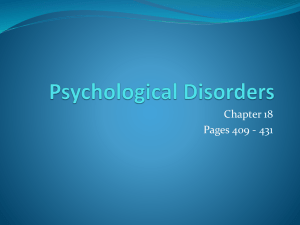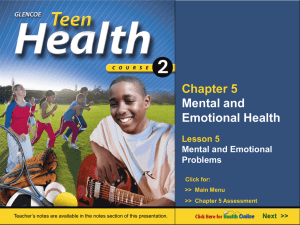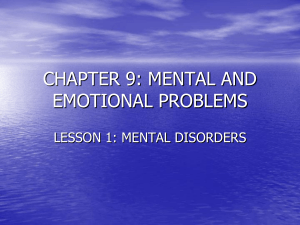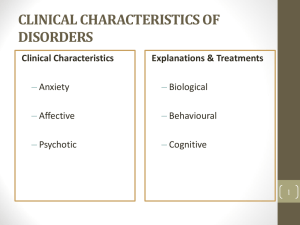Abnormal Psych
advertisement
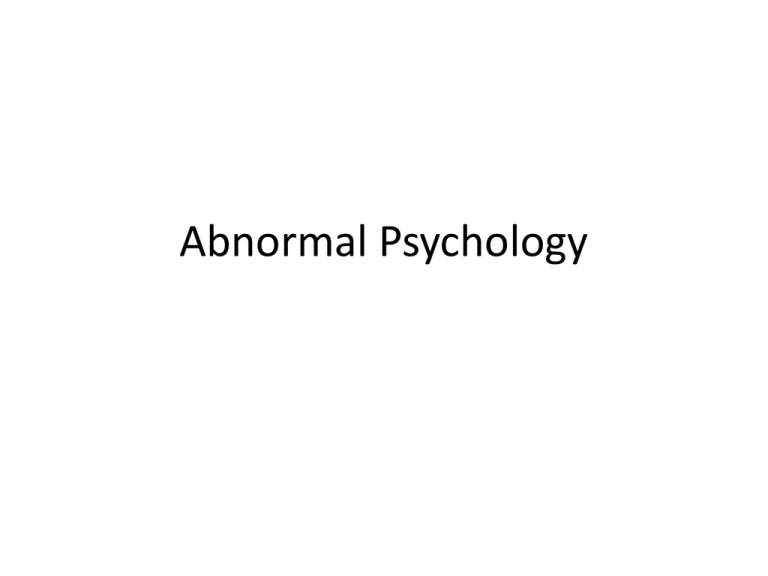
Abnormal Psychology What makes something a disorder? • Typicality – the degree to which the mental process or behavior is average or typical of the majority of people • Maladaptivity – the mental process or behavior impairs an individuals ability to function in everyday life • Emotional Discomfort – the person feels bad • Socially Unacceptable Behavior – behavior that violates societies norms MUCH madness is divinest sense To a discerning eye; Much sense the starkest madness. ’T is the majority In this, as all, prevails. Assent, and you are sane; Demur,—you ’re straightway dangerous, And handled with a chain. 5 Classifying Psychological Disorders • DSM – IV – TR • Diagnostic and Statistical Manual of Mental Disorders • First one came out in 1952 • Fourth edition came out in 1994, TR means Text Revision which is the edition from 2000 • DSM – V is due in 2013 • http://allpsych.com/disorders/disorders_dsmI Vcodes.html Anxiety Disorders • Anxiety – a general state of dread or uneasiness that occurs in response to a vague or imagined danger Types of Anxiety Disorders • Phobic Disorders – a persistent excessive or irrational fear of a particular object or situation • the most common of all anxiety disorders • Panic Disorder and Agoraphobia – panic attacks: a relatively short period of intense fear or discomfort – Agoraphobia – a fear of being in places or situations where escape may be difficult (e.g. the mall) – 50%-80% of phobic individuals treated have one or both of these Generalized Anxiety Disorder • Excessive or unrealistic worry about life circumstances that lasts for at least 6 months Obsessive-Compulsive Disorder • Obsessions – unwanted thoughts, ideas, mental images that occur repeatedly • Compulsions – repetitive ritual behaviors, often involving checking or cleaning • Most people with OCD are aware that their actions are unjustified Stress Disorders • Post Traumatic Stress Disorder (PTSD) • Intense persistent feelings of anxiety that are caused by an experience so traumatic that it would produce stress in almost anyone • e.g. rape, severe child abuse, assault, severe accident, natural disasters, war atrocities • People with PTSD may experience flashbacks, nightmares, numbness of feelings, avoidance of stimuli associated with trauma, increased tension prePTSD? Explaining Anxiety Disorders • Psychoanalytic view – anxiety result of forbidden urges • Learning view – conditioning – Childhood traumatic event (lost in a crowd) – Observation of adult behavior (screaming at spiders) • Cognitive view – people make themselves feel anxious by responding negatively to situations • Biological view – heredity plays a role Dissociative Disorders • Dissociation – the separation of certain mental processes from conscious thought • Happens all the time (daydreaming, reading a book, watching TV) • Disorders are more extreme examples used to avoid stressful events or feelings • Dissociative Amnesia – sudden loss of memory usually followed by a traumatic event • Dissociative Fugue – not only forgetting personal information and past events but also relocating from home or work and taking on a new identity • Dissociative Identity Disorder – also called multiple personality disorder • The existence of two or more personalities within one individual Explaining Dissociative Disorders • Psychoanalytic view – people dissociate to repress unacceptable urges • Learning view – people dissociate to avoid feelings of shame, guilt, or pain. This is reinforced by reduced anxiety when trauma is forgotten • Sybil Somatoform Disorders • Somatization – the expression of psychological distress through physical symptoms • Conversion disorders – a change or loss in physical functioning of major part of the body in which there is no medical explanation • Hypochondriasis - a person’s unrealistic preoccupation with the idea that they have a serious medical illness Explaining Somatoform Disorders • Same as Dissociative Disorders Mood Disorders • Depression – feelings of helplessness, hopelessness, worthlessness, guilt, and great sadness • The most common of all psychological disorders • Some estimates say between 8%-18% of worlds population experience depression at some point in their lives • Major depression is diagnosed when an individual experiences at least five of the following nine symptoms of depression (and one or two of the five have to be the first two): • Persistent depressed mood for most of the day • Loss of interest or pleasure in all or almost all activities • Significant weight loss or gain due to changes in appetite • Sleeping more or less than normal • Speeding up or slowing down of physical and emotional reactions • Fatigue or loss of energy • Feelings of worthlessness or unfounded guilt • Reduced ability to concentrate or make meaningful decisions • Recurrent thoughts of death or suicide Bipolar Disorder • Formerly called manic depression • http://www.youtube.com/watch?v=QYdq0A BH3so • Periods of mania (extreme excitement, hyperactivity, chaotic behavior) followed by periods of depression • Manic moods may also include delusions of grandeur or even hallucinations Explaining Mood Disorders • Psychoanalytic view – child suffers loss of important object or loved one. Child feels anger about loss but internalizes it and blames themselves • Learning view – Learned Helplessness, people come to believe they have no control over events • Cognitive view – some people are prone to depression because of the way they explain events. Do they blame themselves or outside events? Is the problem temporary or permanent? • Biological view – genetics are a key factor • Two neurotransmitters – serotonin and noradrenaline – play a role in mood regulation. Low levels in each may result in depression (causation or downward spiral?) Schizophrenia • • • • • The most serious of psychological disorders Loss of contact with reality, very disabling Typically appears in young adulthood Extremely difficult to treat Relatively rare • Symptoms include: • Hallucinations – often auditory • Voices often tell the person what to do or comment on behavior • Delusions of grandeur or persecution • Thought disorders – people are illogical, disorganized, or confused • A 20th-century artist, Louis Wain, who was fascinated by cats, painted these pictures over a period of time in which he developed schizophrenia. The pictures mark progressive stages in the illness and exemplify what it does to the victim's perception. http://www.dangerousminds.net/comments/louis_wain_the_man_who_drew_cats • The false progression of Louis Wain: http://mindhacks.com/2007/09/26/the-falseprogression-of-louis-wain/ Types of Schizophrenia • Paranoid Schizophrenia – delusions and / or auditory hallucinations relating to a single theme. Often delusions of grandeur or persecution • Disorganized Schizophrenia – delusions and hallucinations but fragmentary and unconnected. Often speak nonsense. • Catatonic Schizophrenia – disturbance of movement • Activity may slow to a stupor and then switch to agitation • May hold unusual body positions for a long time • Sometimes poseable Explaining Schizophrenia • multifactorial Impulse Control Disorders • Trichotillomania - the uncontrollable plucking of one’s hair • Usually limited to hair on the head, but removal of eyebrows, eyelashes and other body hair is not uncommon • Intermittent Explosive Disorder – the inability to control violent impulses • Different than having a bad temper / anger issues but diagnosis is difficult • Pathological gambling - the uncontrollable impulse to gamble • often results in disrupted relationships, financial problems, and/or criminal behavior • Kleptomania - the impulse to steal for no great gain, when he or she has sufficient money to pay for the item and no need for what is stolen. • Pyromania - the uncontrollable impulse to repeatedly set fires with no obvious motive (such as: concealment of a crime, financial gain, and such). • Not Otherwise Specified or NOS • Impulsive Sexual Behaviors • Repetitive Self- Mutilation - While this behavior can be present in a wide range of psychiatric disorders, this impulsive behavior is also part of the Impulse Control Disorder, NOS catchment. It refers to the actions of individuals who fail to resist impulses to episodically cut, carve or burn their skin, interfere with healing of their wounds, and so on. • Compulsive Shopping • Tourette syndrome - a neurological disorder characterized by repetitive, stereotyped, involuntary movements and vocalizations called tics • Although the symptoms of TS are involuntary, some people can sometimes suppress, camouflage, or otherwise manage their tics in an effort to minimize their impact on functioning. However, people with TS often report a substantial buildup in tension when suppressing their tics to the point where they feel that the tic must be expressed (against their will). Tics in response to an environmental trigger can appear to be voluntary or purposeful but are not. Personality Disorders • Patterns of inflexible traits that disrupt social life or work and / or distress the affected individual • Paranoid PD – tend to be distrustful and suspicious of others. Perceive others behavior as insulting or threatening • Schizoid PD – no interest in relationships with other people, they do not become attached to others • Antisocial PD – show a persistent behavior pattern of disregard for, and violation of, the rights of others. No feelings of remorse or guilt • Avoidant PD – these people desire relationships but have tremendous fear of rejection or feelings of inadequacy







